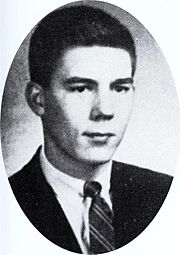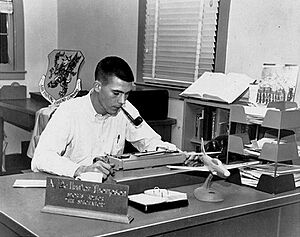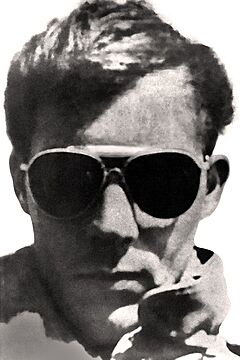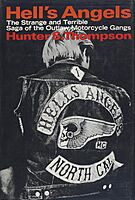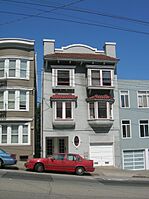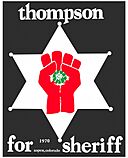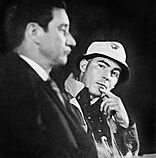Hunter S. Thompson facts for kids
Quick facts for kids
Hunter S. Thompson
|
|
|---|---|
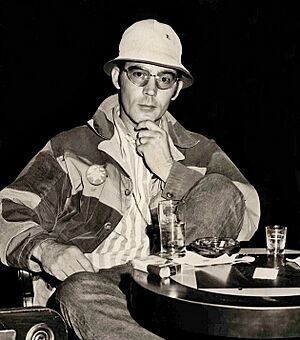
Thompson in 1971
|
|
| Born | Hunter Stockton Thompson July 18, 1937 Louisville, Kentucky, U.S. |
| Died | February 20, 2005 (aged 67) Woody Creek, Colorado, U.S. |
| Genre | Gonzo journalism |
| Literary movement | New Journalism |
| Years active | 1958–2005 |
| Notable works |
|
| Signature | |
 |
|
| Military career | |
| Allegiance | |
| Branch | |
| Service years | 1955–58 |
| Rank | |
| Service number | AF 15546879 |
| Unit | Strategic Air Command, Office of Information Services |
Hunter Stockton Thompson (July 18, 1937 – February 20, 2005) was an American journalist and author. He was a pioneer of a style called New Journalism. He became famous for his book Hell's Angels (1967). To write it, he spent a year with the Hells Angels motorcycle club to understand their lives.
In 1970, he wrote an unusual article called "The Kentucky Derby Is Decadent and Depraved". This article helped him create his own style of writing called Gonzo. In Gonzo journalism, the writer is part of the story and shares their own thoughts and feelings.
Thompson is best known for his book Fear and Loathing in Las Vegas (1972). It tells the story of a wild journey to Las Vegas in search of the "American Dream." He also wrote about politics, most famously in his book Fear and Loathing on the Campaign Trail '72 (1973).
Thompson was known for his unique personality and his strong opinions. He continued to write for magazines like Rolling Stone and ESPN.com throughout his life. He died on February 20, 2005, at the age of 67.
Contents
Early Life and Education
Thompson was born in Louisville, Kentucky. He was the oldest of three sons. His father, Jack, was a World War I veteran, and his mother, Virginia, was a librarian. When Thompson was 14, his father passed away, and his mother raised him and his brothers.
Thompson was interested in sports as a child. In high school, he joined the Athenaeum Literary Association, a writing club. He wrote articles for the club's yearbook, The Spectator. After leaving high school in 1955, he decided to join the United States Air Force.
Military Service and Early Career
Thompson did his basic training in Texas and later studied electronics in Illinois. In 1956, he was transferred to Eglin Air Force Base in Florida. There, he got his first writing job as the sports editor for the base's newspaper, the Command Courier.
In 1958, his commanding officer noted his independent spirit and recommended an early honorable discharge. After leaving the Air Force, Thompson worked for several newspapers in Pennsylvania and New York. He moved to San Juan, Puerto Rico in 1960 to work for a sports magazine. He also wrote for the New York Herald Tribune about issues in the Caribbean.
In the early 1960s, he wrote for the National Observer, a weekly newspaper. During this time, he traveled across the United States and South America. He also began working on his first novel, The Rum Diary, which was not published until many years later in 1998.
Discovering His Voice
Writing Hell's Angels
In 1965, the editor of The Nation magazine hired Thompson to write a story about the Hells Angels motorcycle club. To get a true understanding of the group, Thompson spent a year living and riding with them.
The experience led to his first major book, Hell's Angels: The Strange and Terrible Saga of the Outlaw Motorcycle Gangs, published in 1966. A reviewer for The New York Times called it a "fascinating, and excitedly written book." The book made Thompson a well-known writer.
The Birth of Gonzo Journalism
In 1970, Thompson wrote an article for Scanlan's Monthly magazine called "The Kentucky Derby Is Decadent and Depraved". For the story, he was paired with illustrator Ralph Steadman, who would become his longtime collaborator.
Instead of just reporting on the horse race, Thompson wrote about his own experiences and feelings about the event. This new, personal style became known as Gonzo journalism. The name "Gonzo" was first used by journalist Bill Cardoso, who told Thompson that his Kentucky Derby article was "pure Gonzo." Thompson liked the name and began to use it to describe his work.
Major Works
Running for Sheriff in Aspen
In 1970, Thompson ran for sheriff of Pitkin County, Colorado, where he lived. He ran on the "Freak Power" ticket and had many unusual ideas for the town. His platform included turning streets into grassy parks and renaming Aspen "Fat City."
To get attention, he shaved his head and called his opponent "my long-haired opponent." Thompson wrote about his campaign in an article for Rolling Stone magazine called "The Battle of Aspen". Although he was popular, he did not win the election.
Fear and Loathing in Las Vegas

Thompson's most famous book is Fear and Loathing in Las Vegas. It began as an assignment for Sports Illustrated magazine to write about a motorcycle race in Las Vegas.
The book tells the story of a journalist named Raoul Duke and his lawyer, Dr. Gonzo, as they travel to Las Vegas. Their trip is supposed to be for work, but it turns into a wild and funny adventure as they search for the "American Dream."
The book was first published in two parts in Rolling Stone magazine in 1971. It was a huge success and introduced Thompson's Gonzo style to a large audience.
Fear and Loathing on the Campaign Trail '72
In 1971, Rolling Stone asked Thompson to cover the 1972 United States presidential election. For a year, he traveled with the candidates, including George McGovern and Edmund Muskie, as they campaigned to run against President Richard Nixon.
His articles were collected in the book Fear and Loathing on the Campaign Trail '72. Unlike other reporters, Thompson wrote about the campaign in his personal Gonzo style. He included his own thoughts and feelings, making the story feel more alive.
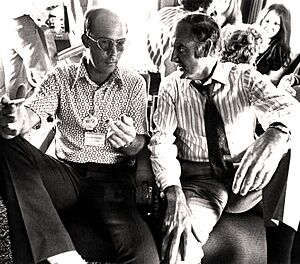
George McGovern's campaign director, Frank Mankiewicz, called the book the "most accurate and least factual" account of the election. This meant that while some events were imagined, the book captured the true feeling of the campaign.
Later Life and Career
After the 1970s, Thompson wrote less frequently but continued to publish important work. He collected many of his best articles in a four-volume series of books called The Gonzo Papers.
He also wrote a column for the The San Francisco Examiner in the 1980s. From 2000 until his death, he wrote a popular online sports column for ESPN.com called "Hey, Rube."
Thompson remained a well-known public figure. In 1998, his early novel The Rum Diary was finally published. That same year, a movie based on Fear and Loathing in Las Vegas was released, bringing his work to a new generation of fans.
On April 23, 2003, Thompson married his assistant, Anita Bejmuk.
Death and Funeral
On February 20, 2005, Thompson died at his home in Woody Creek, Colorado. He was 67 years old. He had been dealing with several health problems.
A special ceremony was held to celebrate his life. Following his wishes, his ashes were launched from a tall, 153-foot tower shaped like a two-thumbed fist. The launch was accompanied by fireworks and music. The event was a unique tribute to his larger-than-life personality, and it was paid for by his close friend, actor Johnny Depp.
Legacy
Gonzo Writing Style
Thompson is known as the creator of Gonzo journalism. This style mixes reporting with the writer's own experiences and imagination. Instead of pretending to be an unseen observer, the Gonzo journalist is a key part of the story.
Writer Tom Wolfe once described the difference between his own style and Thompson's. He said that while he tried to be a "fly on the wall," Thompson was a "fly in the ointment." This meant Thompson was not afraid to get involved in the stories he was covering.
Public Persona
Thompson often wrote as a character named Raoul Duke, who was an exaggerated version of himself. This character became a famous part of his public image. Over time, people sometimes had a hard time telling the difference between the real Thompson and his character. His unique style and personality have been widely imitated, and he remains a popular cultural figure.
Political Views
Thompson was very interested in politics and often wrote about it. He believed strongly in personal freedom and privacy rights. He was a member of the National Rifle Association of America and also helped create the Fourth Amendment Foundation, an organization that helps protect people from illegal searches.
Awards and Tributes
- Thompson was named a Kentucky Colonel in 1996.
- The character Uncle Duke in the comic strip Doonesbury was originally based on Thompson's character, Raoul Duke.
- Author Tom Wolfe called Thompson the greatest American comic writer of the 20th century.
- The character Dale Gribble from the animated show King of the Hill is partly based on Thompson's appearance.
Hunter S. Thompson Quotes
- "A man who procrastinates in his choosing will inevitably have his choice made for him by circumstance."
- "Life has become immeasurably better since I have been forced to stop taking it seriously."
- "When the going gets weird, the weird turn pro."
- "Insanity is a legal term. Crazy is an art form."
- "Beware of looking for goals: look for a way of life."
- "Freedom is something that dies unless it's used."
- "Anything that gets your blood racing is probably worth doing."
See also
 In Spanish: Hunter S. Thompson para niños
In Spanish: Hunter S. Thompson para niños


